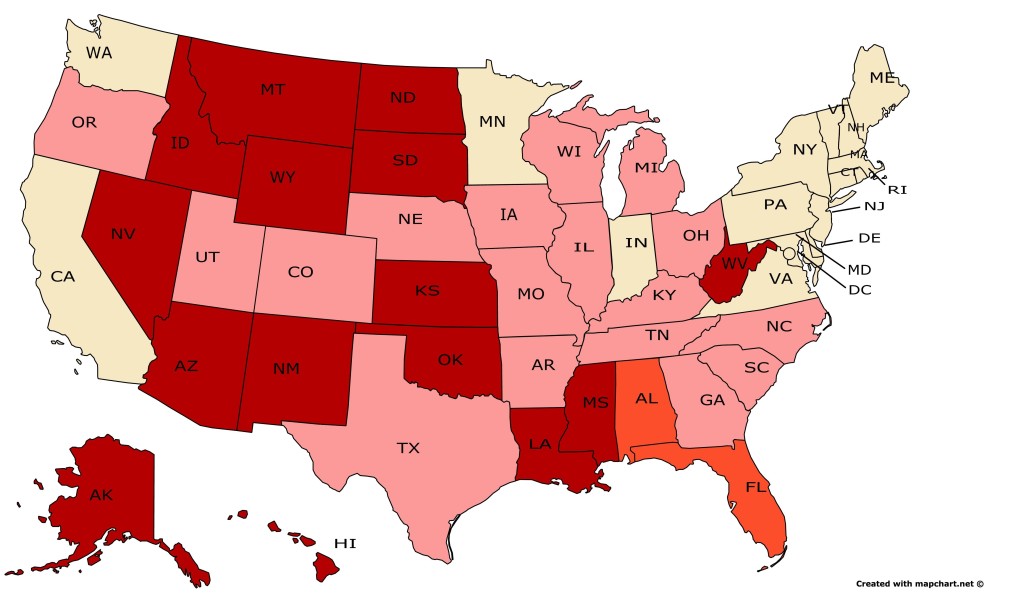Prepare to Travel: Across the U.S. Access to High-Completion-Rate Colleges Uneven
The American Council on Education (ACE) recently published a report on “education deserts” that identified the geographical areas in the United States where there is limited access to higher education institutions. Across the country, the authors identify 295 education deserts, areas where there are either zero colleges and universities or one community college that serves as the only “broad-access” public option. Students in the Midwest and Great Plains states face more deserts than students in other regions. The authors argue that living in an education desert puts students at a disadvantage compared to their peers who live in areas with greater access—recent research indicates that the distance between students’ homes and their closest college is negatively related to their likelihood of enrolling in college, especially for low-income students. Or, in one salient statistic, “57 percent of incoming freshman enroll [in college] within 50 miles of their home.”
Upon reading the ACE report, I immediately started to wonder if there were “high-completion deserts” spanning across states or regions in the U.S. In other words, are there states and districts with zero four-year colleges with six-year graduation rates at or above 70 percent? (I chose to limit my sample to four-year colleges or universities because a majority of US students attend four-year colleges, and of students who attend two-year colleges, a vast majority intend to transfer to four-year schools.) To answer this question, I did a high-level analysis to see how high-completion-rate colleges are distributed across states and regions. To account for differences in the number of colleges in a given state, I also looked at the share of each state’s colleges and universities with six-year graduation rates at or above 70 percent.
Based on IPEDS data, there are 270 four-year colleges, both private not-for-profit and public, that, over the past five years, have an average six-year graduation rate at or above 70 percent. For each state, I compared this list of 270 colleges with the list of all U.S. four-year private not-for-profit and public colleges and universities. Using a handy tool called mapchart.net, I then generated the map below using my findings. As the legend explains, states in the darkest red have no four-year colleges with six-year graduation rates at or above 70 percent. For a high school student in these states who wishes to go in-state to college, the only option is to attend a school where they have less than a seven in ten chance of graduating in six years.
Similarly, only one four-year college in Alabama (3 percent) and three (3 percent) in Florida have six-year graduation rates at or above 70 percent. States in light pink comprise the middle third of the distribution—states with between 4 and 13.5 percent of their colleges with six-year graduation rates at or above 70 percent. Finally, between 13.6 and 25 percent of four-year colleges in beige states have six-year graduation rates at or above 70 percent. Rhode Island (25 percent), Connecticut (23 percent), Massachusetts (22 percent), and Minnesota (22 percent) all have the highest share of high-completion-rate colleges, while New York (31), Pennsylvania (30), California (27), and Massachusetts (22) have the highest numbers of such colleges.
College completion rates, of course, are driven partly by the students who enroll and partly by how well colleges serve the students who enroll. Nearly all of the 270 colleges are selective admission schools. But there are selective schools in the states that are “high-completion deserts”—those selective colleges just aren’t graduating their well-qualified students at high rates.
In combination with the more-granular ACE report, this analysis highlights significant inequities in access faced by students in the Midwest and Great Plains states. Not only do these students have few or zero proximate colleges, but they also have few or zero proximate colleges where their chance of graduating is relatively high. Reducing education deserts is a laudable goal, but without corresponding improvements in student outcomes, our ability to reduce inequity will be limited.
The Share of States’ Four-Year Colleges with Six-Year Graduation Rates at or above 70 Percent

